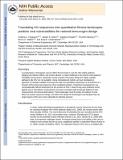| dc.contributor.author | Ferguson, Andrew L. | |
| dc.contributor.author | Mann, Jaclyn K. | |
| dc.contributor.author | Omarjee, Saleha | |
| dc.contributor.author | Ndung'u, Thumbi | |
| dc.contributor.author | Walker, Bruce D. | |
| dc.contributor.author | Chakraborty, Arup K. | |
| dc.contributor.author | Ferguson, Andrew L. | |
| dc.date.accessioned | 2016-02-11T01:51:36Z | |
| dc.date.available | 2016-02-11T01:51:36Z | |
| dc.date.issued | 2013-03 | |
| dc.date.submitted | 2012-06 | |
| dc.identifier.issn | 10747613 | |
| dc.identifier.issn | 1097-4180 | |
| dc.identifier.uri | http://hdl.handle.net/1721.1/101155 | |
| dc.description.abstract | A prophylactic or therapeutic vaccine offers the best hope to curb the HIV-AIDS epidemic gripping sub-Saharan Africa, but it remains elusive. A major challenge is the extreme viral sequence variability among strains. Systematic means to guide immunogen design for highly variable pathogens like HIV are not available. Using computational models, we have developed an approach to translate available viral sequence data into quantitative landscapes of viral fitness as a function of the amino acid sequences of its constituent proteins. Predictions emerging from our computationally defined landscapes for the proteins of HIV-1 clade B Gag were positively tested against new in vitro fitness measurements and were consistent with previously defined in vitro measurements and clinical observations. These landscapes chart the peaks and valleys of viral fitness as protein sequences change and inform the design of immunogens and therapies that can target regions of the virus most vulnerable to selection pressure. | en_US |
| dc.description.sponsorship | Ragon Institute of MGH, MIT and Harvard | en_US |
| dc.description.sponsorship | National Institutes of Health (U.S.) (Director's Pioneer Award) | en_US |
| dc.description.sponsorship | Ragon Institute of MGH, MIT and Harvard (Postdoctoral Fellowship) | en_US |
| dc.language.iso | en_US | |
| dc.publisher | Elsevier/Cell Press | en_US |
| dc.relation.isversionof | http://dx.doi.org/10.1016/j.immuni.2012.11.022 | en_US |
| dc.rights | Creative Commons Attribution-NonCommercial-NoDerivs License | en_US |
| dc.rights.uri | http://creativecommons.org/licenses/by-nc-nd/4.0/ | en_US |
| dc.source | PMC | en_US |
| dc.title | Translating HIV Sequences into Quantitative Fitness Landscapes Predicts Viral Vulnerabilities for Rational Immunogen Design | en_US |
| dc.type | Article | en_US |
| dc.identifier.citation | Ferguson, Andrew L., Jaclyn K. Mann, Saleha Omarjee, Thumbi Ndung’u, Bruce D. Walker, and Arup K. Chakraborty. “Translating HIV Sequences into Quantitative Fitness Landscapes Predicts Viral Vulnerabilities for Rational Immunogen Design.” Immunity 38, no. 3 (March 2013): 606–617. | en_US |
| dc.contributor.department | Institute for Medical Engineering and Science | en_US |
| dc.contributor.department | Massachusetts Institute of Technology. Department of Chemical Engineering | en_US |
| dc.contributor.department | Massachusetts Institute of Technology. Department of Chemistry | en_US |
| dc.contributor.department | Massachusetts Institute of Technology. Department of Physics | en_US |
| dc.contributor.mitauthor | Ferguson, Andrew L. | en_US |
| dc.contributor.mitauthor | Chakraborty, Arup K. | en_US |
| dc.relation.journal | Immunity | en_US |
| dc.eprint.version | Author's final manuscript | en_US |
| dc.type.uri | http://purl.org/eprint/type/JournalArticle | en_US |
| eprint.status | http://purl.org/eprint/status/PeerReviewed | en_US |
| dspace.orderedauthors | Ferguson, Andrew L.; Mann, Jaclyn K.; Omarjee, Saleha; Ndung’u, Thumbi; Walker, Bruce D.; Chakraborty, Arup K. | en_US |
| dc.identifier.orcid | https://orcid.org/0000-0003-1268-9602 | |
| dc.identifier.orcid | https://orcid.org/0000-0002-8829-9726 | |
| dspace.mitauthor.error | true | |
| mit.license | PUBLISHER_CC | en_US |
